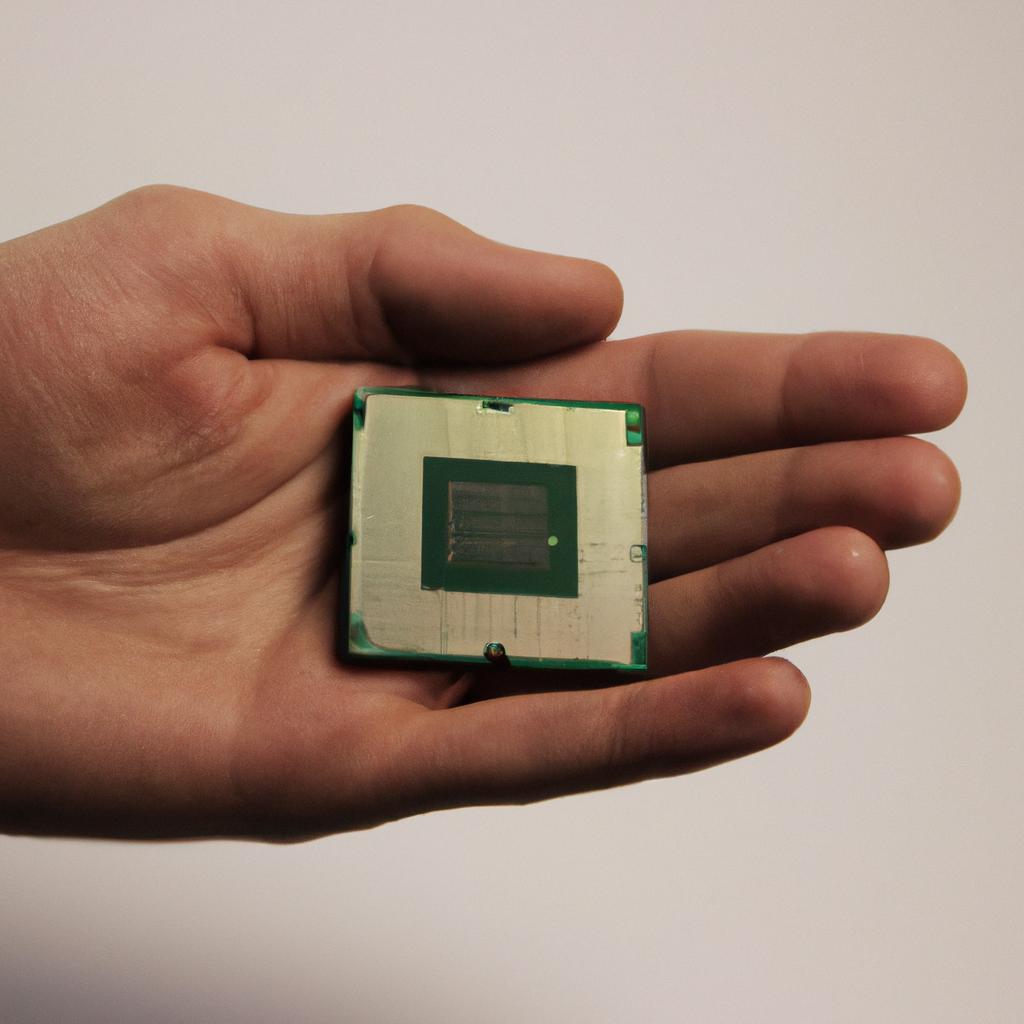Cache latency is a critical factor that affects the performance of computer systems, particularly in relation to the CPU cache. The AMD Platform CPU Cache, specifically, plays a significant role in reducing memory access time and improving overall system efficiency. To illustrate this point, consider a hypothetical scenario where an application requires frequent data retrieval from memory. In such cases, if the CPU cache has high latency, it becomes a bottleneck for processing speed and can negatively impact user experience.
In recent years, there has been a growing emphasis on optimizing cache design to minimize latency and enhance system performance. AMD’s approach to CPU cache architecture aims to address this challenge by implementing innovative techniques that effectively reduce memory access time. Understanding the intricacies of how the AMD Platform CPU Cache works is crucial for software developers, hardware engineers, and researchers alike as it enables them to exploit its full potential and optimize their applications accordingly.
This article delves into the concept of cache latency with a specific focus on the AMD Platform CPU Cache. By examining different aspects such as its structure, organization, and various optimization strategies employed by AMD, readers will gain valuable insights into how these factors influence cache performance and ultimately impact the overall system operation. Additionally, this article also explores real-world case studies showcasing instances where efficient management of efficient management of the AMD Platform CPU Cache has led to significant performance improvements in various applications and workloads.
One such example is in gaming. In modern video games, fast and efficient data access is crucial for delivering smooth gameplay experiences. The AMD Platform CPU Cache plays a vital role in minimizing latency by storing frequently accessed data closer to the CPU cores, reducing the need to fetch data from main memory. This results in faster load times, reduced stuttering, and improved frame rates.
Another example is in scientific simulations or data analysis tasks that involve large datasets. These applications often require frequent access to massive amounts of data stored in memory. By optimizing cache design, AMD allows for better utilization of available cache space and more efficient retrieval of data when needed, reducing the time spent on memory access operations and improving overall computational efficiency.
Furthermore, the AMD Platform CPU Cache also benefits multi-threaded workloads. With multiple threads running simultaneously, it becomes essential to manage cache resources effectively to avoid contention and ensure each thread can access its required data quickly. Through techniques such as cache partitioning and intelligent caching algorithms, AMD optimizes cache utilization across multiple threads, resulting in improved scalability and better overall system performance.
In conclusion, efficient management of the AMD Platform CPU Cache plays a crucial role in enhancing system performance across a wide range of applications and workloads. By minimizing cache latency through innovative design strategies, AMD empowers developers and researchers to harness the full potential of their systems while delivering optimal user experiences.
Cache Hierarchy
Imagine a scenario where you are browsing the internet on your computer, and you click on a link to open a webpage. In order for the webpage to load quickly, your computer relies on its cache hierarchy, which is an essential component of modern processors. The cache hierarchy consists of multiple levels of memory caches that store recently accessed data, allowing for faster retrieval in subsequent operations.
The first level cache, also known as L1 cache, is located closest to the processor core. It has low latency and provides quick access to frequently used instructions and data. This small but fast cache significantly reduces the time it takes for the processor to fetch information from main memory or higher-level caches.
Moving up the hierarchy, we encounter the second level cache, referred to as L2 cache. Although larger than L1 cache in size, it typically operates at a slightly slower speed. However, it still offers faster access compared to accessing data directly from main memory.
Finally, there is the third level cache or L3 cache. This level usually has greater capacity than both L1 and L2 caches but operates at an even lower speed relative to them. Despite being slower, it serves as a shared resource among multiple cores within a processor or across different processors in multi-processor systems.
To understand the significance of these various levels of caching in terms of performance improvement, consider the following:
- Accessing data from L1 cache can be hundreds of times faster than retrieving it from main memory.
- Retrieving data from L2 cache is generally around ten times quicker than fetching it directly from main memory.
- Although slower than both L1 and L2 caches individually, accessing data from L3 cache is still several times faster compared to accessing main memory.
In summary, by incorporating multiple levels of caching into their designs, modern processors optimize performance by reducing latency when accessing frequently utilized instructions and data. By exploiting locality principles and storing copies of data closer to the processor, cache hierarchies effectively minimize the time spent waiting for data retrieval from main memory.
Transitioning into the next section about “Cache Latency Overview,” we will now delve deeper into understanding and measuring cache latency on AMD platforms.
Cache Latency Overview
Cache Latency: The AMD Platform CPU Cache
As we delve deeper into the intricacies of cache hierarchy, it is essential to understand the concept of cache latency. To illustrate its significance, let us consider a hypothetical scenario where a computer system with an AMD processor is running a resource-intensive application such as video editing software.
In this scenario, the CPU cache plays a crucial role in improving system performance by reducing memory access times. However, each level of the cache hierarchy introduces its own unique latency characteristics that impact overall system responsiveness. Let’s explore these latencies further.
Firstly, at the L1 cache level, which is closest to the processing cores, data can be accessed with minimal latency. This high-speed cache allows for rapid retrieval of frequently used instructions and data. It acts as a buffer between the processor and main memory, significantly reducing memory access time.
Moving up to the L2 and L3 caches in subsequent levels of the hierarchy, we encounter slightly increased latencies due to their larger sizes and greater distances from the processing cores. While they still provide faster access than main memory, their higher capacities result in longer search times for requested data.
To better grasp these differences in cache latency across various levels within an AMD platform CPU cache architecture, let’s consider some key points:
- The L1 cache has lower latency compared to both L2 and L3 caches.
- The size of each cache level increases moving away from the processing cores.
- Larger caches store more data but have longer access times.
- As we move up through the hierarchy from L1 to L2 to L3 caches, there is an increase in both capacity and latency.
Table: Cache Latency Overview
| Cache Level | Size | Access Time |
|---|---|---|
| L1 | Small | Low |
| L2 | Medium | Moderate |
| L3 | Large | High |
This table summarizes the key characteristics of cache latency in an AMD platform CPU cache. It helps visualize how different levels of the cache hierarchy offer varying trade-offs between capacity and access time.
Understanding these latency differences is crucial for optimizing performance-critical applications on AMD-based systems. By leveraging this knowledge, developers can make informed decisions about data placement and caching strategies to minimize memory access times further.
With a solid understanding of cache latency and its impact on system performance, we can now explore the intricacies of the AMD CPU Cache Architecture in greater detail. This next section will shed light on the specific design choices made by AMD to optimize their cache architecture for enhanced processing capabilities.
AMD CPU Cache Architecture
Having examined the overview of cache latency, we now turn our attention to exploring the AMD CPU cache architecture. To illustrate its practical significance, let us consider a hypothetical scenario where an online gaming platform experiences frequent lag and performance issues due to high cache latency.
In this scenario, players on the online gaming platform often face delays in their actions being registered in real-time during gameplay. These delays can be attributed to the time it takes for data to be retrieved from different levels of cache memory within the AMD CPU. Understanding the intricacies of the AMD CPU cache architecture is crucial in addressing such latency-related challenges and optimizing system performance.
The AMD CPU cache architecture consists of multiple levels of caches that work together to store and retrieve frequently accessed data quickly. Let’s delve into some key aspects:
- Cache hierarchy: The AMD CPU employs a multi-level hierarchical structure consisting of L1, L2, and sometimes even L3 caches. Each level has varying sizes and proximity to the processor cores, with smaller but faster caches closer to the core.
- Cache organization: Caches are organized into sets containing multiple lines or blocks of data. Within each line or block, there are sub-blocks called cache ways that hold subsets of data associated with specific addresses.
- Cache coherence protocols: In order to maintain consistency across all levels of cache when multiple processors access shared data simultaneously, sophisticated protocols like MESI (Modified, Exclusive, Shared, Invalid) or MOESI (Modified, Owned, Exclusive, Shared, Invalid) are employed.
- Replacement policies: When new data needs to be fetched into a full cache set while preserving important existing information, replacement policies dictate which blocks should be evicted based on various algorithms such as least recently used (LRU) or random selection.
In conclusion,
understanding how the AMD CPU cache architecture functions lays a solid foundation for comprehending another crucial aspect – cache coherency
Cache Coherency
Cache Coherency and Its Importance
Imagine a scenario where multiple processors in a system are accessing the same data simultaneously. Without proper coordination, this can lead to inconsistencies and errors, undermining the reliability of the system as a whole. This is where cache coherency comes into play, ensuring that all processors have consistent views of shared memory locations. Let’s explore the significance of cache coherency in maintaining data integrity.
To better understand the role of cache coherency, consider a hypothetical case study involving two processors – Processor A and Processor B – both equipped with their respective caches (L1, L2, etc.). Suppose they are executing separate threads but need access to the same piece of data stored in main memory. Here’s how cache coherency ensures data consistency:
- Invalidation: When Processor A modifies the shared data item in its cache (L1), it invalidates other copies of that item present in Processor B’s cache. This ensures that any subsequent reads from Processor B will fetch updated values from main memory or Processor A.
- Update propagation: Conversely, if Processor B modifies the shared data item first, it sends an update request to invalidate other copies held by other processors. The modified value then propagates through the caches to ensure consistency across all levels.
The importance of cache coherency becomes evident when considering potential issues without it:
| Potential Issues | Impact |
|---|---|
| Data inconsistency | Inconsistent views of shared data could result in incorrect computations |
| Race conditions | Concurrent execution might introduce race conditions and logical flaws |
| Deadlocks | Improper synchronization between processors may lead to deadlocked states |
In conclusion, cache coherency plays a vital role in multi-processor systems by ensuring consistent and reliable communication between different caches sharing common memory locations. By employing mechanisms such as invalidation and update propagation, it prevents potential issues like data inconsistency, race conditions, and deadlocks. Understanding the importance of cache coherency lays the foundation for optimizing system performance and reliability.
Moving forward into our exploration of cache latency measurement, we will delve deeper into how cache access times are determined and the various factors that impact them.
Cache Latency Measurement
Cache Latency: The AMD Platform CPU Cache
Moving forward from our discussion on cache coherency, let us delve into the concept of cache latency in the context of the AMD platform’s CPU cache. To better understand this topic, consider a hypothetical scenario where an application running on an AMD processor requires frequent access to data stored in memory. In such a case, optimizing cache latency becomes crucial for enhancing overall system performance.
To begin with, it is essential to recognize that cache latency refers to the time taken for a processor to fetch data from its various levels of cache. This delay is incurred due to factors like cache size, proximity to the core, and access mechanisms employed by the processor architecture. By minimizing cache latency, we can significantly reduce the amount of time spent waiting for data retrieval operations.
To highlight the significance of addressing cache latency issues, here are some key points:
- Reduced wait times: Decreasing cache latency allows processors to retrieve frequently accessed data faster and thus minimizes idle periods.
- Enhanced responsiveness: Lowering cache latency improves overall system response times, leading to smoother user experiences and increased productivity.
- Improved computational efficiency: Optimizing cache latency can boost processing speeds by reducing bottlenecks caused by long wait times.
- Energy savings: Efficient management of cache latency helps conserve power consumption as shorter retrieval times translate into reduced energy requirements.
Now let us explore how different levels of AMD platform caches contribute to varying latencies through the following table:
| Cache Level | Capacity | Proximity | Latency |
|---|---|---|---|
| L1 | 32 KB | Closest | Low |
| L2 | 256 KB | Intermediate | Moderate |
| L3 | 8 MB | Farthest | High |
This table underscores how each level has differing capacities and proximities relative to the CPU core. As we move further away from the core, cache latency tends to increase. Understanding these variations is crucial for designing efficient algorithms and optimizing memory access patterns.
In conclusion, addressing cache latency in the AMD platform’s CPU cache is vital for achieving optimal system performance. By reducing wait times, enhancing responsiveness, improving computational efficiency, and conserving energy, optimization efforts can have a significant impact on overall user experience. In our next section about “Cache Latency Optimization,” we will explore various strategies to mitigate cache latency issues further.
Transitioning into the subsequent section on Cache Latency Optimization
Cache Latency Optimization
In the previous section, we discussed the measurement of cache latency and its importance in understanding the performance of a CPU cache. Now, let us delve into the realm of cache latency optimization, where techniques are employed to minimize these latencies and enhance overall system performance.
To illustrate the significance of cache latency optimization, consider a hypothetical scenario where an application requires frequent access to a large dataset stored in memory. Without efficient caching mechanisms, every data access request would result in time-consuming trips to main memory. However, by optimizing cache latency, we can reduce this overhead significantly, resulting in faster execution times and improved responsiveness for such applications.
There are several strategies that can be utilized to optimize cache latency. Firstly, prefetching algorithms can be implemented to anticipate future data accesses and bring them into the cache ahead of time. By proactively loading frequently accessed data into the cache, subsequent requests can be fulfilled more quickly without waiting for main memory retrieval.
Secondly, adjusting cache parameters such as associativity and replacement policies can also impact cache latency. For example, increasing associativity allows for more concurrent accesses within the same set, reducing potential conflicts and improving hit rates. Similarly, employing intelligent replacement policies ensures that valuable cached data is retained while evicting less useful data from the cache.
Moreover, architectural enhancements like larger caches or multiple levels of caching can further mitigate latency issues. By increasing the size of each level or introducing additional layers of caches with varying speeds and capacities (known as multi-level caching), processors can improve their ability to store frequently accessed data closer to processing units.
Optimizing cache latency plays a crucial role in enhancing system performance across various computing domains. By incorporating effective prefetching algorithms, fine-tuning cache parameters, and leveraging architectural advancements like multi-level caching systems; developers have significant opportunities to reduce latencies at different stages of memory hierarchy—ultimately leading to superior computational efficiency and user experience.
Bullet Points:
- Reduced cache latency results in faster execution times and enhanced responsiveness for applications that rely on frequent data access.
- Prefetching algorithms can be employed to bring frequently accessed data into the cache proactively, reducing main memory retrieval overhead.
- Adjusting cache parameters such as associativity and replacement policies helps optimize hit rates and mitigate conflicts.
Table:
| Technique | Description | Benefits |
|---|---|---|
| Prefetching | Proactive loading of anticipated data accesses into the cache | Reduces waiting time for main memory retrieval |
| Cache parameter | Tuning associativity, replacement policies, and other parameters to optimize cache behavior | Enhances hit rates and mitigates conflicts |
| Architectural | Introduction of larger caches or multiple levels of caching systems | Improves storage proximity to processing units |
In summary, optimizing cache latency is a crucial aspect of system performance enhancement. Through techniques like prefetching algorithms, adjusting cache parameters, and leveraging architectural advancements, developers have numerous opportunities to reduce latencies at different stages of the memory hierarchy. By doing so, they can improve computational efficiency and user experience across a wide range of computing domains.




